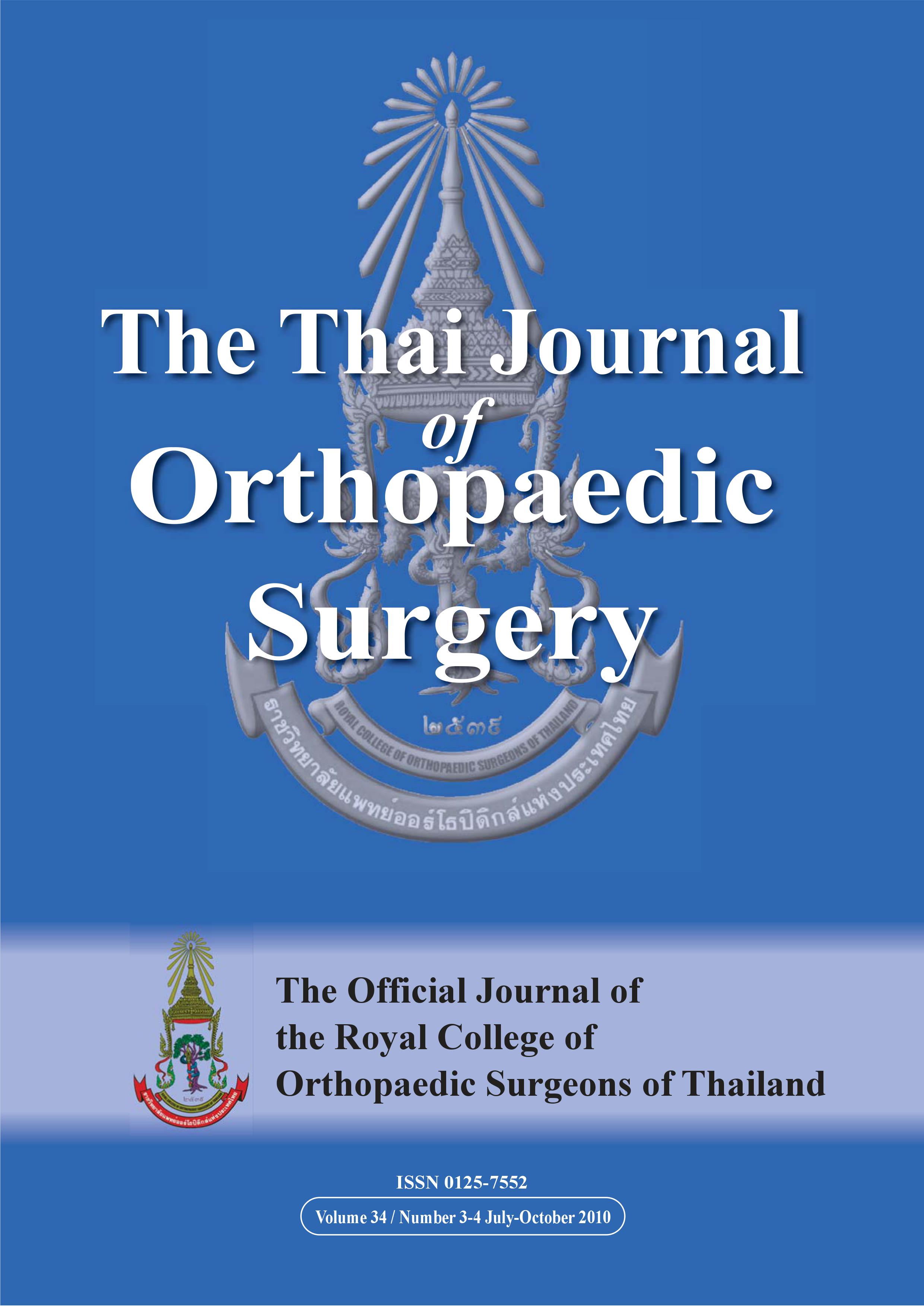การศึกษาเปรียบเทียบตำแหน่งของข้อเทียมในการทำผ่าตัดเปลี่ยนข้อสะโพกเทียมระหว่างวิธี lateral และ posterior approach ในโรงพยาบาลปทุมธานี
Main Article Content
บทคัดย่อ
วัตถุประสงค์: เพื่อศึกษาความแตกต่างของตำแหน่งข้อเทียมที่ได้จากการทำ total hip arthroplasty ด้วยวิธี lateral approach และ posterior approach
วัสดุและวิธีการ: เป็นการศึกษาเชิงวิเคราะห์เปรียบเทียบแบบย้อนหลังโดยรวบรวมข้อมูลจากภาพถ่ายรังสีและเวชระเบียนของผู้ป่วยที่รับการรักษาโดยการผ่าตัดเปลี่ยนข้อสะโพกเทียม ทุกรายในโรงพยาบาลปทุมธานีตั้งแต่ปี พ.ศ.2545-2553
ผลการศึกษา: จากผู้ป่วย 93 คน 107 สะโพก พบอัตราส่วนเพศชายต่อเพศหญิง อายุ และ การวินิจฉัยโรคทั้งสองกลุ่ม ไม่แตกต่างกันอย่างมีนัยสำคัญทางสถิติ ตำแหน่งของข้อเทียมที่วัดได้ ได้แก่ acetabular cup inclination, vertical height, horizontal distance และ anteversion ไม่แตกต่างกันอย่างมีนัยสำคัญทางสถิติ แต่ femoral stem ในกลุ่ม posterior approach มีแนวโน้มที่จะเป็น varus alignment ซึ่งแตกต่างกับ lateral approach ซึ่งมีแนวโน้มเป็น valgus alignment อย่างมีนัยสำคัญทางสถิติ ซึ่งส่งผลให้กลุ่ม posterior approach มี offset มากกว่ากลุ่ม lateral approach อย่างมีนัยสำคัญทางสถิติ ซึ่งเชื่อว่าเกิดจากตำแหน่งของ proximal femur ที่แตกต่างกันขณะใส่ femoral stem ประเด็น limb length discrepancy ของทั้งสองกลุ่มไม่มีความแตกต่างกันอย่างมีนัยสำคัญทางสถิติ
สรุป: femoral stem ในกลุ่ม posterior approach มีแนวโน้มที่จะเป็น varus alignment ซึ่งแตกต่างกับ lateral approach ซึ่งมีแนวโน้มเป็น valgus alignment อย่างมีนัยสำคัญทางสถิติ ข้อมูลดังกล่าวสามารถนำไปใช้เป็นแนวทางในการป้องกันการวางตำแหน่งข้อเทียมที่ผิดพลาดตาม approach ที่เลือกใช้ในการทำผ่าตัดเปลี่ยนข้อสะโพกเทียม
Article Details
เอกสารอ้างอิง
2. Bozic KJ, Freiberg AA, Harris WH. The high hip center. Clin Orthop Relat Res. 2004(420): 101-5.
3. Ackland MK, Bourne WB, Uhthoff HK. Anteversion of the acetabular cup. Measurement of angle after total hip replacement. J Bone Joint Surg Br. 1986; 68(3): 409-13.
4. Yoder SA, Brand RA, Pedersen DR, O'Gorman TW. Total hip acetabular component position affects component loosening rates. Clin Orthop Relat Res. 1988 (228): 79-87.
5. D'Lima DD, Urquhart AG, Buehler KO, Walker RH, Colwell CW Jr. The effect of the orientation of the acetabular and femoral components on the range of motion of the hip at different head-neck ratios. J Bone Joint Surg Am. 2000; 82(3): 315-21.
6. Masonis JL, Bourne RB. Surgical approach, abductor function, and total hip arthroplasty dislocation. Clin Orthop Relat Res. 2002(405): 46-53.
7. Demos HA, Rorabeck CH, Bourne RB, MacDonald SJ, McCalden RW. Instability in primary total hip arthroplasty with the direct lateral approach. Clin Orthop Relat Res. 2001(393): 168-80.
8. McGrory BJ, Morrey BF, Cahalan TD, An KN, Cabanela ME. Effect of femoral offset on range of motion and abductor muscle strength after total hip arthroplasty. J Bone Joint Surg Br. 1995; 77(6): 865-9.
9. Woo RY, Morrey BF. Dislocations after total hip arthroplasty. J Bone Joint Surg Am. 1982; 64(9): 1295-306.
10. Maruyama M, Feinberg JR, Capello WN, D'Antonio JA. The Frank Stinchfield Award: Morphologic features of the acetabulum and femur: anteversion angle and implant positioning. Clin Orthop Relat Res. 2001(393): 52-65.
11. Ritter MA, Harty LD, Keating ME, Faris PM, Meding JB. A clinical comparison of the anterolateral and posterolateral approaches to the hip. Clin Orthop Relat Res. 2001(385): 95-9.
12. Delp SL, Wixson RL, Komattu AV, Kocmond JH. How superior placement of the joint center in hip arthroplasty affects the abductor muscles. Clin Orthop Relat Res. 1996(328): 137-46.
13. Pagnano W, Hanssen AD, Lewallen DG, Shaughnessy WJ. The effect of superior placement of the acetabular component on the rate of loosening after total hip arthroplasty. J Bone Joint Surg Am. 1996; 78(7): 1004-14.
14. Ritter MA, Zhou H, Keating CM, Keating EM, Faris PM, Meding JB, et al. Radiological factors influencing femoral and acetabular failure in cemented Charnley total hip arthroplasties. J Bone Joint Surg Br. 1999; 81(6): 982-6.


